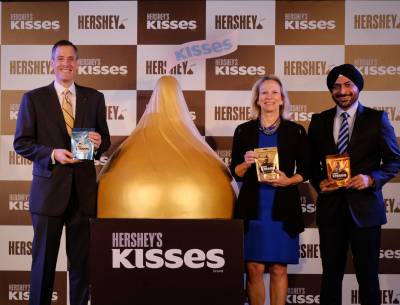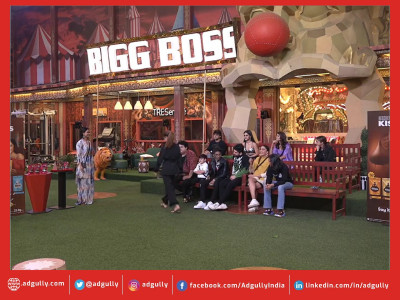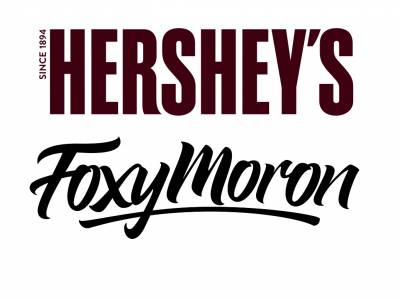Hershey’s Kisses now in India; company to invest $50 mn over next 5 years
Hershey India, a part of The Hershey Company, a leading global snacking giant and the largest producer of quality chocolates in North America, has launched its iconic ‘Hershey’s Kisses’ chocolate brand in India. Hershey’s Kisses are distinct because of their unique shape.
During the first phase of this launch, Hershey’s Kisses will be available only in South India. It will be available in modern trade, large general trade and e-commerce platforms in South India.
Commenting on the launch, Michele Buck, President and CEO, The Hershey Company, said, “The Hershey Company has a rich chocolate heritage and we have built our expertise over the past 125 years. Hershey’s Kisses is one of our most iconic chocolate treats and a symbol of how our company has spread its goodness around the world.”
Steven Schiller, President, International, The Hershey Company, added here, “There is a lot of potential for The Hershey Company in India. This market is an important part of our International growth model. The Hershey’s brand has been leading our India growth and Hershey’s Kisses is a wonderful way to continue that growth by tapping into the growing chocolate segment.”
Speaking about the product launch and the brand’s future plans, Herjit Bhalla, Managing Director, Hershey India, said, “We are delighted that consumers are increasingly loving the Hershey’s range of products – be it Hershey’s Syrups, Spreads, Milk Shakes or Cocoa Powder. I am very excited about Hershey’s strategic entry into the large chocolate category with Hershey’s Kisses. We know from our intensive consumer testing and product development that Indian consumers will love Hershey’s Kisses, and I am sure Hershey’s will now spread smiles and happiness to many more homes.”
Available in India in three variants – Milk Chocolate, Almonds, and Cookies ‘n’ Crème, the Hershey’s Kisses range in India is the result of intensive R&D and consumer testing to develop the right taste profile for discerning Indian consumers who seek premium chocolate.
The journey of the Hershey’s brand in India started a decade ago with the introduction of the Hershey’s Chocolate Syrup, and brand has emerged as a clear market leader in chocolate syrups and cocoa powder. More than two years ago, Hershey’s launched products in Milk Shake and Chocolate Spreads. According to a company release, in 2018, Hershey’s is the No. 2 brand in Chocolate Spreads and the No. 3 brand in Milk Shakes in just two years of their launch. The launch of Hershey’s Kisses is expected to further fuel the growth of the Hershey’s brand in India.
The Hershey Company brings almost 125 years of chocolate-making experience to the launch of Hershey’s Kisses in India. Today, it is a Fortune 500 company with world-class manufacturing expertise and innovation capabilities to deliver great tasting chocolates. The company makes nearly 70 million Hershey’s Kisses every day that are sold in nearly 60 countries.
At a Media Roundtable, Michelle Buck, President & CEO, The Hershey Company; Steven Schiller, President, International, The Hershey Company; and Herjit Singh Bhalla, Managing Director, Hershey India, fielded several queries on the company’s investment plans in India, marketing strategy, growth trajectory and much more. Excerpts:
How much investment are you are going to make in this project? How are you going to fight the competition from Cadbury, Nestle, Amul, etc., which is about $1.2 billion, as you say?
Michelle Buck: We believe in what we are bringing to the market place, which is a significant investment. We have committed around $50 million over the next 5 years. We have invested in manufacturing capacity. We will be investing in advertising, including TV and digital, as well as in-store activation.
As far as competition is concerned, first of all, this is a growing market and thus, provides us the key opportunity to drive the growth. We believe that Hershey’s is a brand that is so unique vis-à-vis anything else that is there in the market place.
What is the projected market share that you have set for yourself in the next 3-5 years?
Steven Schiller: Today, you witnessed probably the biggest surge by Hershey’s in India. The shopping market is $1.2 billion, and Hershey’s has established itself as a leading player in every single category that we are present in. So, at this stage we would want to consolidate our presence in chocolates. We already launched Brookside three years ago and now with the introduction of Kisses, we will look to solidify our presence among the chocolate brands.
As of now you are only focusing on the Southern markets. How are you going to phase out in the next few months so that the entire country is covered?
Herjit Singh Bhalla: First and foremost, the Hershey Company is committed to driving growth across the country. We are initially launching the product in the Southern part of the country and it is going to be present in larger trade and modern trade like e-commerce soon. That is because the South constitutes one-third of the total chocolate market and secondly, we have done all of these approaches in the past and it has delivered good results for us. So, we personally believe that this is a winning formula that we have and we are sticking to it. We will be going to the rest of the country very soon.
Your launch comes just in time for the festive season. What are you plans?
Herjit Singh Bhalla: This is a really auspicious time of the year, so we were very excited that we could launch right at the start of the festive season. Currently, the aim is to take these two packs and make it available in the South and going forward that is the plan.
From a global perspective, where does India stand for Hershey’s as a market?
Steven Schiller: We don’t break out the individual markets, but I can say that within the international model as I look each of our global geographies, there is probably more potential in India than any other market based on where we are today and where we are with our portfolio. Just the sheer size of the population and the strong economy which is giving lot of purchasing power to the consumers creates a really ripe environment for people to partake in the snacking spectrum that we offer. I think the opportunity is in front of us and India will become a bigger and bigger piece of the company’s performance.
We have four brands that are at our core in India – Sofit, Brookside, Hershey’s and Jolly Rancher. These brands are growing at 50 per cent right now and we feel really good about that. The growth, going forward, is also going to be robust. The snacking spectrum opportunities in India are really exciting and because we have a multi brand line-up, each of those brands means different things, which are going to allow us to explore different areas of the snacking landscape. I think you are going to see more category entries from us in the right spaces for the right reasons. Even this year we are going to have a pretty auspicious launch.
How much does India contribute to global revenues?
Steven Schiller: We don’t break out revenues from individual segments. We have groups – the North America and Canada segment and an international segment, which includes Mexico, Brazil, India, China and all the export markets. It also includes licensing and world travel retail. That segment is about 12 per cent of the total company. But honestly, what is most important for our discussion today is the potential of India, where we are bringing our most iconic product to a market that has so much potential.
What is the market contribution of e-commerce platforms?
Herjit Singh Bhalla: E-commerce is an emerging channel, especially in the area of groceries. We are looking at driving aggressive growth through e-commerce. The average FMCG companies would be between 1 per cent and 2 per cent of our business contribution. We are looking at doing much more than that.
We committed last year that we are going to invest $50 million in this market over the course of the next five years. This is the first year of that strategy. We are committed to building our strategy for the India business and Hershey’s is at the core of that strategy. In the last few years, we have launched milk shakes and chocolate spreads and today, we have come out with Kisses. The focus largely is going to be to build these new brands.
Steven Schiller: We have a multi-year outlook for building these brands for strategic purposes and that investment was part of that. While the Kisses launch is news today, we have been working on this for quite some time. We have a measured way of thinking about our growth model, which includes manufacturing capability, feet on the street for sales, the capability to train our personnel to do the things that we need to do and the investments required to launch and drive various brands.
What is your pricing strategy?
Herjit Singh Bhalla: We are launching at two price points and we believe that to have Hershey’s Kisses available at Rs 50 is a very attractive price point. I think the team has done a wonderful job to create a formulation that our consumers love and give value to our consumers in terms of a Rs 50 price point. We believe that we are delivering ahead of expectations and that the consumer should be delighted with it.
What is your marketing strategy?
Herjit Singh Bhalla: Tara Sharma is going to be the face of this campaign. She has been an integral part of our journey for many years. She is the Hershey’s mom who is going to continue spreading happiness as we introduce Hershey’s Kisses. We have introduced a marketing plan that is a complete 360-degree plan, which includes media, PR, activation, in-store visibility, and we will be driving go-to market excellence so that we can make our product visible and available in the South markets from day one.
Digital is something where we have been developing our capabilities, and this year we have invested in both capability and increased spends online. It is definitely going to be a big focus. Digital is going to be one of the leading drivers as part of the marketing campaign for Hershey’s Kisses.
What would be your reach on the e-commerce platforms?
Herjit Singh Bhalla: The reach is restricted to the large metros at this point. Our aim is to ensure that this iconic chocolate brand reaches our consumers in the manner and shape that it is intended to reach – that is the most important part. The consumer needs to have the experience that they simply love. The focus is going to be in ensuring that our consumers get the product at the right places with the right cooling environment.
Steven Schiller: I have spent time with the e-commerce platforms and have seen the way they have evolved and it is very interesting. There are a couple of choices that we are embracing here. The first one is that the evolution from brick & motors to e-commerce happens much faster, starts small and then there is a critical mass which happens very fast. In consumer durables, it is a decision taken after a few researches; but when it comes to fresh food, people want to pick their own stuff rather than relying on somebody else, so fresh moves last. So, you can follow this progression to see how e-commerce is evolving.
Chocolates, like ice cream, create an interesting conundrum for e-commerce – the last mile delivery, how you keep the temperature controlled to have the right experience as consumers can be very discerning if they get something that is melted or not good. That is something that is still to be figured out on a mass scale. For example, in a city like Mumbai, if there is a dedicated warehouse then the product can reach the consumer in a short period of time, so when this happens then all categories will move fast.
China, on the other hand, is in the other end of the spectrum that has the most evolved e-commerce business in the world for all categories – it is already 15-16 per cent, which is a very big number. You have cities of 20 million+ people in China that have the ability to bring the last mile infrastructure in the most cost effective way and that has given rise to the shift in the category. You would think that the US is a much more mature market, but the infrastructure is different. Cost of delivery is more expensive in a city like New York City, which has a population of only 9 million.
In India, if the e-commerce players like Amazon and Flipkart figure out the last mile quickly and invest in air conditioned warehouses, especially in larger cities like Mumbai and Delhi, then these items will move much faster. We are doing all the right things and are setting up to be part of that evaluation as the customers want to experience it and the infrastructure has to be there.








Share
Facebook
YouTube
Tweet
Twitter
LinkedIn